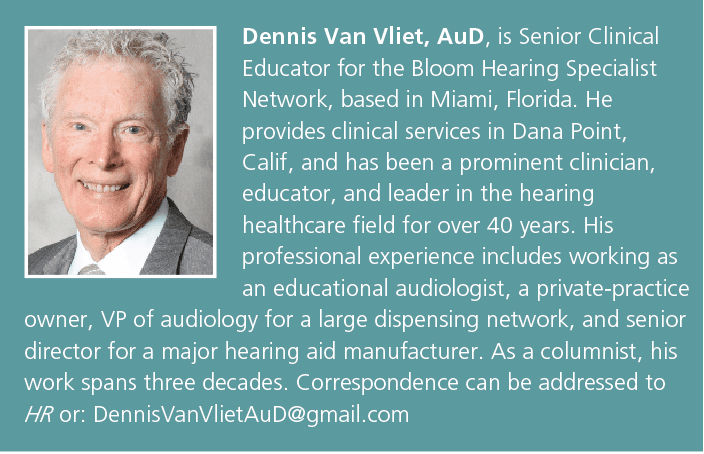Final Word | January 2020 Hearing Review
By Dennis Van Vliet, AuD
In our world what is considered best practice? In a December 2017 Hearing Review interview with Michael Valente, PhD, Doug Beck, AuD, asked about Dr Valente’s “Greatest Hits” for inclusion in best-practice protocols for adult hearing aid fittings. Among other key recommendations, Dr Valente offered the following:
• A needs assessment, including unaided speech recognition in noise;
• Coupler measurements of the hearing aids, verifying adherence to specs;
• Real-ear measures (REM) and aided speech-in-noise testing,
• Validation measures to assess outcomes.
Recently, an independent group of audiologists circulated a communication titled “A Concern for the Profession” outlining concerns about observations of shortcomings in the clinical practices of some practitioners. Among the concerns were the following:
• Failing to perform speech-in-noise measures,
• Only following manufacturer fitting algorithms rather than evidence-based targets,
• Failing to verify that hearing aids are programmed to best meet patients’ needs,
• Failing to explore if augmentative services would be beneficial or desired,
• Failing to adequately discuss cochlear implant (CI) options when hearing levels and processing abilities are no longer remedied effectively by hearing aids.
I’ve edited both of these to focus on points to be discussed in this column. Clearly there are many valid concerns about what should be done to follow best practices, and different viewpoints, depending on the circumstances. The concern is that best practices may be too frequently ignored.
A key component that is stressed any time best practices are discussed is verification that the hearing aid fitting is appropriately addressing the degree and configuration of the hearing loss. Verification is typically with objective, real-ear measure. Opponents to real-ear measures may argue that verification does not assure satisfaction or benefit and comfort, and I would agree, to a point. What verification measures does offer is a solid reference for assurance that the most basic goal of a hearing aid fitting, audibility, has been met, as well as what happens with louder sounds. We may need to make changes from what appears to be a reasonable fit, but the objective measures are much more informative than a cartoon in the programming software or an answer to “How does that sound?” We may get by without measurement, but the use of properly executed objective measures is precise, gives the patient confidence in our work, and serves to document what we have done far better than a smile and a nod from the patient.
Coupler measures are an important tool. Unfortunately, I think 2cc measures are are less commonly used in clinics than they were a couple of decades ago. If that is the case, I think we are missing an important diagnostic step in monitoring the performance of hearing aids. It is easy to depend upon listening checks and real ear, but there are times when there is no substitute for a solid bench test to compare the performance of a device to a previous measure.
Unaided SIN testing is a revealing and important tool to demonstrate to the patient what obstacles they may face in their efforts to achieve better communication. This testing may not be appropriate for all patients. However, stressing a system so that performance improvements are easier to demonstrate can establish a patient’s confidence in a fitting, and guide the treatment plan toward considering additional augmentative approaches.
The use of remote microphones, telecoils, and other augmentative devices and services are often peripheral to the fitting of hearing aids as they may be seen as cumbersome, intrusive, or an obstacle to the spontaneity of free-flow social communication. This may be true for some, but there is a time and place for such devices and we should not neglect a discussion of their use when appropriate.
As discussed in this column in the past, CIs have been established as an important treatment for hearing loss when the criteria have been met. Discussing CIs before the patient is a candidate sets an important target for the future, comforts those patients who fear losing all of their hearing at some point, and educates and prepares the population who may very well need CIs at some point. Failing to discuss CIs, especially when the time is right, is a disservice.
The Final Word? It is only human to look for faster and more efficient ways to accomplish tasks. When it comes to providing essential capabilities for people who have hearing difficulties, however, it makes more sense to focus on best rather than fast or efficient. If it is true that many hearing care professionals do not follow best practices, what better way to enhance our personal stature as professionals and effectiveness as clinicians then to set ourselves apart by following best practices?

Correspondence can be addressed to HR or: [email protected]
Citation for this article: Van Vliet D. Offering your patients a best-practice outcome. Hearing Review. 2020;27(1).





